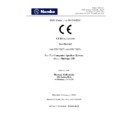JBL ON STAGEII (serv.man6) EMC - CB Certificate ▷ View online
Nemko USA, Inc.
11696 Sorrento Valley Road, Suite F, San Diego, CA 92121
Phone (858) 755-5525 Fax (858) 452-1810
DATE
DOCUMENT NAME
DOCUMENT #
PAGE
Janurary 5,2006
Harman Multimedia OnStage UD CE Test Report
2006 011114 CE AUS/NZ
17 of 72
Figure 2. Conducted Emissions Test Setup Diagram
N
OT TO
S
CALE
CONFIGURATION LEGEND
1. Test Laboratory (6 X 6 meters)
2. Ground Plane (15 square meters)
3. Vertical Conducting Wall (Grounded through Ground Plane via 10' ground rod)
4. AC Power for Devices
5. Power Line Filter, Lindgren, 120 dB, 30 amp
6. Artificial Mains Network (AMN) for peripheral devices
7. Power Distribution Box for peripheral devices
8. Spectrum Analyzer with Quasi-Peak Adapter
9. High Pass Filter
10. Coax input from EUT AMN to Spectrum Analyzer
11. AMN for EUT
12. EUT: Computer Speaker System and Associated System
2. Ground Plane (15 square meters)
3. Vertical Conducting Wall (Grounded through Ground Plane via 10' ground rod)
4. AC Power for Devices
5. Power Line Filter, Lindgren, 120 dB, 30 amp
6. Artificial Mains Network (AMN) for peripheral devices
7. Power Distribution Box for peripheral devices
8. Spectrum Analyzer with Quasi-Peak Adapter
9. High Pass Filter
10. Coax input from EUT AMN to Spectrum Analyzer
11. AMN for EUT
12. EUT: Computer Speaker System and Associated System
8
7
40 cm
9
4
1
2
3
6
5
11
12
13
10
Nemko USA, Inc.
11696 Sorrento Valley Road, Suite F, San Diego, CA 92121
Phone (858) 755-5525 Fax (858) 452-1810
DATE
DOCUMENT NAME
DOCUMENT #
PAGE
Janurary 5,2006
Harman Multimedia OnStage UD CE Test Report
2006 011114 CE AUS/NZ
18 of 72
3.3. Configuration and Methods of Measurements for Frequency Identification
When performing all testing of equipment, the actual emissions of the EUT are segregated from ambient
signals present within the laboratory or the open-field test range. Preliminary testing is performed to ensure
that ambient signals are sufficiently low to allow for proper observation of the emissions from the EUT.
Ambient signals within the laboratory are compared to those noted at the nearby open-field site to
discriminate between signals produced from the EUT and ambient signals. In the event that a significant
emission is produced by the EUT at a frequency that is also demonstrating significant ambient signals, the
spectrum analyzer is placed in the peak mode, the bandwidth is narrowed and the EUT's signal is centered on
the analyzer. The scan width is expanded to 50 kHz while monitoring the audio to ensure that only the EUT
signal is present, the analyzer is switched to quasi-peak mode, and the level of the EUT signal is recorded.
Nemko USA, Inc.
11696 Sorrento Valley Road, Suite F, San Diego, CA 92121
Phone (858) 755-5525 Fax (858) 452-1810
DATE
DOCUMENT NAME
DOCUMENT #
PAGE
Janurary 5,2006
Harman Multimedia OnStage UD CE Test Report
2006 011114 CE AUS/NZ
19 of 72
Figure 3. Frequency ID of Radiated Emissions Test Setup Diagram
NOT TO SCALE
CONFIGURATION LEGEND
1. Test Laboratory
2. Spectrum Analyzer with Quasi-Peak Adapter
3. Coax interconnect from Antenna to Spectrum Analyzer
4. Receive Antenna (basic relative position)
5. Non-Conducting table 80 cm above ground plane
6. Power strip for EUT and peripherals
7. AC power for devices
8. EUT: Computer Speaker System and Associated System
1
8
1m
2
3
4
5
6
7
Nemko USA, Inc.
11696 Sorrento Valley Road, Suite F, San Diego, CA 92121
Phone (858) 755-5525 Fax (858) 452-1810
DATE
DOCUMENT NAME
DOCUMENT #
PAGE
Janurary 5,2006
Harman Multimedia OnStage UD CE Test Report
2006 011114 CE AUS/NZ
20 of 72
3.4. Configuration and Methods of Measurements for Radiated Emissions
EN 55022 also specifies limits and methodology for radiated emissions testing. Initially, the primary emission
frequencies are identified inside a shielded chamber by positioning a broadband receive antenna one meter
from the EUT. Next, the EUT and associated system are placed on a turntable on a ten-meter open area test
site (OATS) with known attenuation characteristics and all significant radiated emissions are recorded. To
ensure that the maximum emission at each discrete frequency of interest is observed, the receive antenna is
varied in height from one to four meters and rotated to produce horizontal and vertical polarities, and the
turntable is also rotated to determine the worst emitting configuration. The numerical results of the test are
included herein to demonstrate compliance. The numerical results of the test are included herein to
demonstrate compliance.
The numerical results that are applied to the emissions limits are arrived at by the following method:
Example: A=RR+CL+AF
A = Amplitude dBuV/M
RR = Receiver Reading dBuV
CL = cable loss dB
AF = antenna factor dBm-1
Example Frequency = 110MHz
18.5 dBuV (spectrum analyzer reading)
+3.0 dB (cable loss @ frequency)
21.5 dBuV
+15.4 dBm-1 (antenna factor @ frequency)
36.9 dBuV/M Final adjusted value
The final adjusted value is then compared to the appropriate emission limit to determine compliance.
Click on the first or last page to see other ON STAGEII (serv.man6) service manuals if exist.

